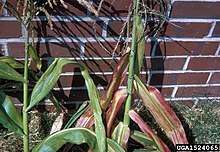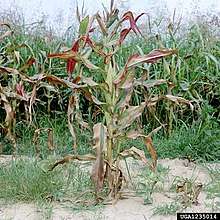Corn stunt disease
Corn stunt disease is a bacterial disease of corn and other grasses. Symptoms include stunted growth and leaves turning red. It is caused by the bacterium Spiroplasma kunkelii.[1]


Disease Cycle
S. kunkelii, a spiroplasma often referred to as Corn Stunt Spiroplasma, can survive and overwinter in D. maidis (DeLong and Wolcott), which infects corn plants in the spring and causes Corn Stunt disease.[2][3] It has been reported in the San Joaquin Valley in California that volunteer plants are critical to help leafhoppers survive in the winter, where volunteer plants can give an extra two months of season to the leafhoppers.[3] This pathogen has been described as propagative persistent and circulative, accumulating and replicating in the vector where it has been found in the hemolymph, cells of the gut, and salivary glands of insect vectors. During feeding it is delivered to the phloem tissue of the host corn plant.[4][5][6][7]
There is an important relationship that S. kunkelii has with D. maidis, where its survival over the winter depends on the survival of the leafhopper.[3] This relationship may also be beneficial for D. maidis. When Dalbulus leafhoppers are infected with S. kunkelii, it has been reported that fertility and life-expectancy are diminished.[6] However, specific to D. maidis, one study suggests that the presence of S. kunkelii increases chances of D. maidis survival in colder weather, specifically 10-20 degrees Celsius, when either given oats or lived on moist sand, although this effect on survival was not found to be true in the case of freezing temperatures.[8] Similarly, one group suggests that the spiroplasma may provide useful metabolites for its leafhopper vector.[6]
S. Kunkelii can be transmitted by other leafhopper genera,[9] however the leafhopper D. maidis is of most significance in Latin America.[10][11][9][12][13]
Management
The most effective way to control Corn Stunt is early planting. Although Corn Stunt can impact corn planted in early months like April or March, the greatest damage affects corn planted after July.[2] Chemicals like insecticides can be used to control D. maidis,[14][15][16] however, the use of this method to control Corn Stunt is not very successful.[2][16] In sweet corn, reflective mulches can be an effective way to control D. maidis and the disease it vectors, compared to insecticides.[17] Mulching should be performed early in the plant’s development to properly control this disease, as greater damage happens if the plant host is younger when infected with Corn Stunt disease.[16][17] Although D. maidis is the major vector for S. kunkelii,[12] one study calls for a focus on all vectors that can transmit Corn Stunt disease, since, in addition to D. maidis, three other species of Dalbulus are able to spread and carry Corn Stunt Spiroplasma.[18]
Importance
S. kunkelii, the Corn Stunt Spiroplasma, was characterized as the causative agent of Corn Stunt disease by Whitcomb et al. in 1986.[19][20] In the literature, the combination of maize bushy stunt mycoplasma and maize rayado fino maravirus in addition to S. kunkelii has been called the Corn Stunt disease complex, also called “achaparramiento.” The combination of these diseases is devastating and all of these can be transmitted by D. maidis. Because of the pathogens and it can transmit, D. maidis is of great financial importance in Latin America.[21][16][22][23][11][12][9][13] Also, maize chlorotic dwarf virus has also been reported to be implicated in Corn Stunt disease.[21] When Corn Stunt Spiroplasma and maize bushy stunt mycoplasma may co-occur, the disease that they can cause has been referred to as “puca poncho” due to its red coloring of the diseased maize.[12] Different combinations of these pathogens are notably present and cause serious problems in yield production in Central America, reported in Nicaragua,[23] Peru,[12] and Argentina,[24][25] and the southern part of the United States, where it was reported in California[3] and Florida.[26][25] Despite the common co-occurrence with other causative agents, S. kunkelii is the most prevalent in the subtropics as the causative agent of Corn Stunt disease and can be quite devastating.[25][24]
References
- https://www.freshfromflorida.com/content/download/11380/144576/pp373.pdf
- "UC IPM: UC Management Guidelines for Corn Stunt on Corn". ipm.ucanr.edu. Retrieved 2018-12-12.
- Summers, C. G.; Newton, A. S.; Opgenorth, D. C. (2004-12-01). "Overwintering of Corn Leafhopper, Dalbulus maidis (Homoptera: Cicadellidae), and Spiroplasma kunkelii (Mycoplasmatales: Spiroplasmataceae) in California's San Joaquin Valley". Environmental Entomology. 33 (6): 1644–1651. doi:10.1603/0046-225x-33.6.1644.
- Özbek, Elvan; Miller, Sally A; Meulia, Tea; Hogenhout, Saskia A (March 2003). "Infection and replication sites of Spiroplasma kunkelii (Class: Mollicutes) in midgut and Malpighian tubules of the leafhopper Dalbulus maidis". Journal of Invertebrate Pathology. 82 (3): 167–175. doi:10.1016/s0022-2011(03)00031-4.
- ALIVIZATOS, A. S.; MARKHAM, P. G. (June 1986). "Multiplication of corn stunt spiroplasma in Dalbulus maidis and transmission in vitro, following injection". Annals of Applied Biology. 108 (3): 545–554. doi:10.1111/j.1744-7348.1986.tb01993.x.
- Hogenhout, S. A.; Özbek, E. (2002). "Abstract: Differential pathogenicity of corn stunt spiroplasma to its Dalbulus leafhopper vectors: electron microscopic findings". Phytopathology. Pub. No. P-2002-0023-SSA.
- G., Markham, P. (1983). Spiroplasmas in leafhoppers: a review. Yale Journal of Biology and Medicine. OCLC 679347314.
- Ebbert, Mercedes A.; Nault, Lowell R. (1994-06-01). "Improved Overwintering Ability in Dalbulus maidis (Homoptera: Cicadellidae) Vectors Infected with Spiroplasma kunkelii (Mycoplasmatales: Spiroplasmataceae)". Environmental Entomology. 23 (3): 634–644. doi:10.1093/ee/23.3.634.
- Nault, L. R. (1980). "Maize Bushy Stunt and Corn Stunt: A Comparison of Disease Symptoms, Pathogen Host Ranges, and Vectors". Phytopathology. 70 (7): 659. doi:10.1094/phyto-70-659.
- Moya-Raygoza, Gustavo; Hogenhout, Saskia A.; Nault, Lowell R. (2007-10-01). "Habitat of the Corn Leafhopper (Hemiptera: Cicadellidae) During the Dry (Winter) Season in Mexico". Environmental Entomology. 36 (5): 1066–1072. doi:10.1603/0046-225x(2007)36[1066:hotclh]2.0.co;2.
- Nault, L. R. (1990). "Evolution of an insect pest: maize and the corn leafhopper, a case study". Maydica. 35.2: 165–175.
- Nault, L. R.; Gordon, D. T.; Loayza, J. Castillo (September 1981). "Maize Virus and Mycoplasma Diseases in Peru". Tropical Pest Management. 27 (3): 363–369. doi:10.1080/09670878109413806.
- Moya-Raygoza, Gustavo; Nault, Lowell R. (1998-09-01). "Transmission Biology of Maize Bushy Stunt Phytoplasma by the Corn Leafhopper (Homoptera: Cicadellidae)". Annals of the Entomological Society of America. 91 (5): 668–676. doi:10.1093/aesa/91.5.668.
- Gabrys, Beata; Capinera, John L.; Legaspi, Jesusa C.; Legaspi, Benjamin C.; Long, Lewis S.; Capinera, John L.; Ellis, Jamie; Weber, Donald C.; Saska, Pavel; Chaboo, Caroline S.; Wiener, Linda; Cresswell, James; Giberson, Donna; Orphanides, George M.; Klotz, John H.; Hansen, Laurel D.; Capinera, John L.; Heppner, John B.; Sikes, Derek S.; Hangay, George; Heppner, John B.; Neuenschwander, Peter; Bellotti, Anthony C.; Capinera, John L.; Hinkle, Nancy C.; Koehler, Philip G.; Taylor, Steven J.; Slaney, David; Weinstein, Philip; et al. (2008). "Corn Leafhopper, Dalbulus maidis (Delong and Wolcott) (Hemiptera: Cicadellidae)". Encyclopedia of Entomology. pp. 1072–1074. doi:10.1007/978-1-4020-6359-6_10037. ISBN 978-1-4020-6242-1.
- Bhirud, K. M.; Pitre, H. N. (1972). "Bioactivity of Systemic Insecticides in Corn: Relationship to Leafhopper Vector Control and Corn Stunt Disease Incidence12". Journal of Economic Entomology. 65 (4): 1134–1140. doi:10.1093/jee/65.4.1134.
- Hruska, Allan J.; Peralta, Modesto Gomez (1997-04-01). "Maize Response to Corn Leafhopper (Homoptera: Cicadellidae) Infestation and Achaparramiento Disease". Journal of Economic Entomology. 90 (2): 604–610. doi:10.1093/jee/90.2.604.
- Summers, C. G.; Stapleton, J. J. (2002-04-01). "Management of Corn Leafhopper (Homoptera: Cicadellidae) and Corn Stunt Disease in Sweet Corn Using Reflective Mulch". Journal of Economic Entomology. 95 (2): 325–330. doi:10.1603/0022-0493-95.2.325.
- Ebbert, Mercedes A.; Jeffers, Daniel P.; Harrison, Nigel A.; Nault, Lowell R. (October 2001). "Lack of specificity in the interaction between two maize stunting pathogens and field collected Dalbulus leafhoppers". Entomologia Experimentalis et Applicata. 101 (1): 49–57. doi:10.1046/j.1570-7458.2001.00890.x.
- Whitcomb, R. F.; Chen, T. A.; Williamson, D. L.; Liao, C.; Tully, J. G.; Bove, J. M.; Mouches, C.; Rose, D. L.; Coan, M. E. (1986-04-01). "Spiroplasma kunkelii sp. nov.: Characterization of the Etiological Agent of Corn Stunt Disease". International Journal of Systematic Bacteriology. 36 (2): 170–178. doi:10.1099/00207713-36-2-170.
- "Spiroplasma kunkelii (corn stunt spiroplasma)". www.cabi.org. Retrieved 2018-12-12.
- Nault, L.R.; Bradfute, O.E. (1979). "Corn Stunt: Involvement of a Complex of Leafhopper-Borne Pathogens". Leafhopper Vectors and Plant Disease Agents. pp. 561–586. doi:10.1016/b978-0-12-470280-6.50021-0. ISBN 9780124702806.
- Moya-Raygoza, Gustavo; Trujillo-Arriaga, Javier (1993). "Evolutionary relationships between Dalbulus leafhopper (Homoptera: Cicadellidae) and its dryinid (Hymenoptera: Dryinidae) parasitoid". Journal of the Kansas Entomological Society: 41–50 – via JSTOR.
- Hruska, Allan J.; Gladstone, Sarah M.; Obando, Rafael (1996). "Epidemic Roller Coaster: Maize Stunt Disease in Nicaragua". American Entomologist. 42 (4): 248–252. doi:10.1093/ae/42.4.248.
- P., Virla, Eduardo G. Díaz, C.G. Carpane, P. Laguna, Isidro G. Ramallo, J. Gerónimo Gómez, L. Giménez Pecci, M. (2004). Evaluación preliminar de la disminución en la producción de maíz causada por el "Corn Stunt Spiroplasma" (CSS) en Tucumán, Argentina. Ministerio de Agricultura, Alimentación y Medio Ambiente: Centro de Publicaciones Agrarias, Pesqueras y Alimentarias. OCLC 668523457.
- Carloni, E.; Carpane, P.; Paradell, S.; Laguna, I.; Giménez Pecci, M. P. (2013-08-01). "Presence of Dalbulus maidis (Hemiptera: Cicadellidae) and of Spiroplasma kunkelii in the Temperate Region of Argentina". Journal of Economic Entomology. 106 (4): 1574–1581. doi:10.1603/ec12323.
- Bradfute, O. E. (1981). "Corn Stunt Spiroplasma and Viruses Associated with a Maize Disease Epidemic in Southern Florida". Plant Disease. 65 (10): 837. doi:10.1094/pd-65-837.